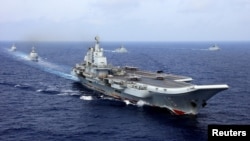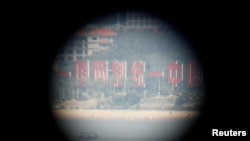Taiwan, faced with an increase in military spending by its main rival China, is seeking a range of new, advanced weapons systems from the United States, officials in Taipei confirmed this week.
Taiwan President Tsai Ing-wen said Tuesday in Taipei that her government had made a formal request to the United States for advanced fighter jets. Local media say she wants 66 American-made F-16 Viper fighter jets, an upgrade over Taiwan’s existing F-16 fleet. A defense ministry spokesperson reached Wednesday did not rule out that possibility.
Taiwan’s armed forces rank 22nd in the world. China ranks much higher, behind only the United States and Russia, and outspends Taiwan on weaponry. This year Beijing announced a 7.5 percent defense budget increase, compared with Taipei’s 5.6 percent hike this year. And with Chinese threats to reunify with the self-ruled island, by force if necessary, regional analysts say Taiwan is keen to boost its military preparedness, with U.S. help, to counter any threat from the mainland.
“I think it’s trying to emphasize that Taiwan is a very close U.S. ally and also sending a political message that we are urgently in need of U.S. support,” said Andrew Yang, secretary-general of the think tank Chinese Council of Advanced Policy Studies in Taiwan.
China’s modernization
China’s People’s Liberation Army is restructuring and advancing technologically, the U.S. defense department said in its annual report to Congress last year. It’s eyeing Taiwan in particular, the report says.
To restructure the armed forces, China has shifted personnel away from the army to its navy and air force to win any “local wars” characterized by “real-time, data-networked command and control, and precision strike,” the Pentagon report says. To modernize, China is shifting toward outer space technology and cyber capabilities, the report says.
“Because for the past few years China’s investment in defense has been extremely fast, that has caused this severe imbalance. Taiwan basically must arm and defend itself, so we hope that in terms of defense we can achieve a sense of balance and develop what we need to develop,” Taiwan ruling party legislator Lee Chun-yi said. For the current arms sale request, he said, “that’s our initial motivation.”
Defense analysts have said Taiwan would best resist China through asymmetrical warfare, meaning effective resistance of an enemy with targeted firepower rather than overwhelming force.
Informal U.S. alliance
U.S. officials will evaluate the purchase request for 120 working days, Taiwan defense ministry spokesman Chen Chung-chi said. They would decide, he said, what exact kinds of aircraft and other weapons systems, such as radars, Taiwan should buy. An arms package would probably include training for Taiwan’s armed forces, Chen said.
Defense officials in Washington declined to comment on the latest request.
Although China bristles whenever the U.S. government announces arms sales to Taiwan, Washington cites a 40-year-old congressional act that allows it to defend the island. The United States sees Taiwan as one of several democratic friends in the Western Pacific, valuable as China becomes more powerful militarily and economically.
President Donald Trump’s administration has particularly favored Taiwan as it pressures China over trade issues. The administration agreed to sell Taiwan $1.42 billion in advanced arms in mid-2017. In October last year, the U.S. Congress approved a $330 million sale of spare parts for military aircraft and other weaponry.
Existing Taiwanese air force jets, including older F-16s, Mirage 2000s and domestically produced fighters, are aging after 20 years of use, Chen said. To keep up with China’s “ceaseless” military research and development as well as “frequent” exercises off the coast, Taiwan needs better planes, Chen said.
“We hope this purchase of advanced fighters will let us improve our air defense safety. China’s military power after all is always growing, so we need to have some defensive capability,” Chen said. “This is an extremely important key to maintaining peace in the region.”






